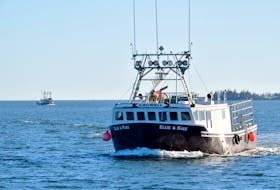
The article goes on to state “New Glasgow, N.S. has been awarded the major prize of the national war finance committee for the best promotional idea to support the recent fourth victory loan campaign.”
During the First and Second World Wars, the Canadian Government issued “Victory Loans” or “War Bonds” as a way to finance military operations and other costs associated in the two conflicts. “A variety of products were offered for investment: war savings stamps, war savings certificates and War Bonds.” Over the two world wars, billions of dollars were raised from all walks of life in Canada. “Canadians responded with generous hearts, opening their wallets and purses to buy the bonds.”
The Federal government invested millions in marketing the bond sales with movie trailers, radio commercials, colourful posters, full-page newspaper advertisements, celebrity endorsements, parades, ceremonies and national contests. It was in 1944 that the Town of New Glasgow would win a countrywide contest.
The National War Finance Committee was seeking ideas from cities and towns across Canada to promote the “Victory Bond.” The submitted entry was from New Glasgow’s high school. They initiated “a surprise parade through the downtown section. Smart stepping cadets behind a pipe band illustrated the democratic way of life which was contrasted by refugees trudging in chains.”
This winning entry was top overall, of the five class community population categories. Class A, communities under 3,000 people, was won by Acton, Ont. Class B (3,000-10,000) was won by New Glasgow, Class C (10,000-30,000) won by Moose Jaw, Sask., Class D (30,000-100,000) won by Saskatoon, Sask, Class E (more then 100,000) won by Vancouver B.C.
For the top prize the Town of New Glasgow received an “illuminated scroll,” was to have its name inscribed on the nose of the first Canadian-made Lancaster bomber. The other entries would receive scrolls and “will have Canadian-made de Havilland Mosquito bombers named after them. However, New Glasgow would have to settle with its name emblazoned on Mosquito Bomber KB 162.
The Mosquito Bomber was de Havilland’s greatest triumphs in the Second World War. It was the fastest multi-role combat aircraft of its time. Mostly built of plywood, it had nicknames such as “the Wooden Wonder,” “Termites Dream” or just called “Mossie” by its crewmembers.
Canada built over 250 Mosquito’s at its Downsview, Ont. top-secret manufacturing plant from September 1941 to 1945. An example of engineering ingenuity inspired by the challenges of war, the Mosquito’s all wooden design was a major advantage during a time of acute shortages of light metal alloys. Most of the aircraft was made of plywood. The fuselage was a “frameless shell made of balsa wood sandwiched between sheets of birch.”
“In July, 1943 Canadian Government officials journeyed south from Ottawa to witness a special nose art christening ceremony. The first of five built Mosquito’s were named after cities and towns across Canada for winning contests and donating the most money in the last Victory Bond drive.” The aircraft named “Acton, Ontario,” “New Glasgow, Nova Scotia” (KD 162), “Moose Jaw-Saskatoon, Saskatchewan” and “Vancouver, B.C.,” were unveiled on the tarmac and soon ferried over the Atlantic to operations in England.
KB 162 joined 139 (Jamaica) Squadron of the Royal Air Force. The Squadron was involved in some of the most intense bombing raids in the Second World War. That summer of 1943 the 139 Squadron began night raids. Its main duty was to “proceed the heavy bombers and drop window (thin strips of metal foil) to confuse the enemy’s early warning radar, and making “spoof” raids on other targets to divert enemy night targets from the primary target attacks by the “heavies.”
It was during one of these night raids that KB 162 met its fate. The KB 162 “New Glasgow” was sent to Warboys, Royal Air Force Station in Huntingdonshire, England. On Friday Oct. 14, 1944 at approx 2:47 A.M., KB 162 (New Glasgow) took off from Warboys Airfield on a bombing mission to Kolm, Germany. The engine cut out at takeoff and two minutes later KB 162 crashed. On impact the bomb load exploded killing Flight Lieutenant Norman Taylor and Flight Officer Walter Jackson.
De Havilland Mosquito Bomber KD 162, New Glasgow, Nova Scotia was damaged beyond repair.
John Ashton of Bridgeville is a local historian and the province’s representative to the Historic Sites and Monuments Board of Canada.








